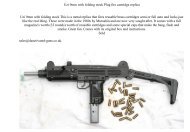FM 23-11 90MM RECOILLESS RIFLE, M67
FM 23-11 90MM RECOILLESS RIFLE, M67
FM 23-11 90MM RECOILLESS RIFLE, M67
You also want an ePaper? Increase the reach of your titles
YUMPU automatically turns print PDFs into web optimized ePapers that Google loves.
(2) Closing the breech.<br />
(3) Firing the piece.<br />
c. Discussion of functioning may start with any of the three phases. Assuming that a cartridge has been<br />
fired, phases then occur as shown in b above. This represents one complete cycle of functioning.<br />
d. Opening the Breech.<br />
(1) Unlocking.As the lockring (8, fig. 6) is rotated clockwise to unlock the breechblock (5, fig. 6), a<br />
cam surface on the interior of the lockring (8, fig. 6) comes in contact with the sear (9, fig. 6) and<br />
moves it inward. The cam surface exerts pressure against the firing hammer (<strong>11</strong>, fig. 6), forcing the<br />
firing hammer and firing pin spring (2, fig. 6) rearward. As the lockring (8, fig. 6) is further rotated<br />
clockwise, it is arrested by the detent plunger (10, fig. 6) and at this point the breechblock (5, fig. 6)<br />
is unlocked.<br />
(2) Cocking. The weapon is normally cocked by opening the breechblock; however, the weapon<br />
may be cocked without opening the breechblock. This is accomplished by rotating the lockring to<br />
the unlocked position and then rotating it back to the locked position without opening the<br />
breechblock. When the lockring is rotated to the unlocked position and the breechblock is swung to<br />
the open position, it pivots on the hinge pin (4, fig. 6). A tooth on the inner hinge portion of the<br />
breechblock engaged in a recess on the extractor link (6, fig. 6) cams the extractor link and<br />
extractor (7, fig. 6) rearward out of the chamber.<br />
e. Closing the Breech. As the breechblock is swung to the closed position, the tooth on the inner hinge<br />
portion of the breechblock retracts the extractor link (6, fig. 6) and extractor (7, fig. 6) into the chambers.<br />
As the lockring is rotated counterclockwise to the locked position, the cam surface on the interior of the<br />
lockring allows the sear (9, fig. 6) to move outward and become engaged with the hinge block end of the<br />
cable assembly.<br />
f. Firing the Piece. When the breechblock is swung to the open position the recoilless rifle safety<br />
automatically positions itself to the safe position. To fire the weapon the safety must be rotated from the<br />
SAFE to the FIRE position. When the trigger safety is depressed the trigger assembly is unlocked. As the<br />
trigger assembly is squeezed pressure is applied to the bottom of the cable actuating lever which pivots on<br />
the spring pin and imparts a pull on the cable assembly. As the cable assembly moves forward, the hinge<br />
block end of the cable assembly releases the sear allowing it to move forward under pressure from the<br />
firing pin spring. As the firing hammer is released, the firing pin spring propels the firing pin against the<br />
primer, firing the projectile.<br />
Section III. MALFUNCTIONS, STOPPAGES, AND<br />
IMMEDIATE ACTION<br />
<strong>11</strong>. Malfunctions and Restoration of Balance<br />
When a recoilless weapon functions properly, it does not move when fired. The forces acting on the rifle




